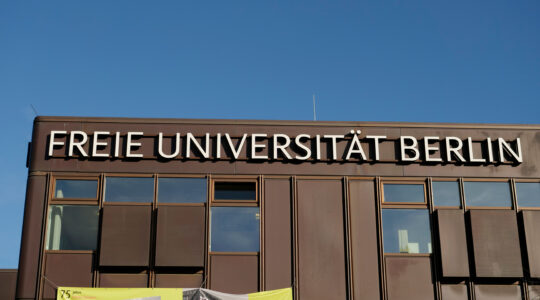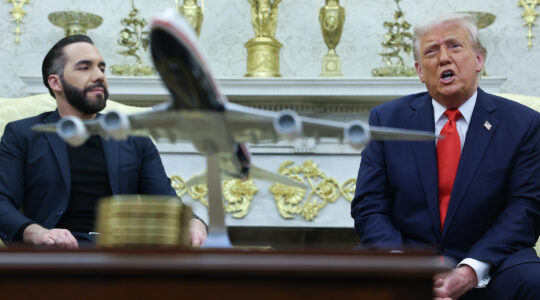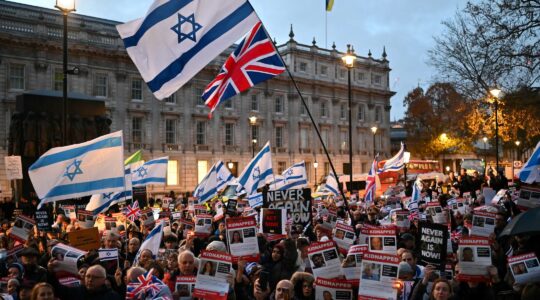USTIA, Ukraine (JTA) – The old man by the pig farm said Jews are buried there. Somewhere.
With that tip in mind, an unlikely French-Ukrainian team of investigators drives along a bumpy dirt track, past a watermelon patch ripening under the hot July sun. The road ends abruptly at the foot of a sunflower field.
Misha Strutinsky, a square-jawed Ukrainian ballistics expert, leaps into action. Decked out in a beret, fatigues and combat boots, Strutinsky clutches his spade in one hand and a metal detector in the other.
Trudging into knee-high sunflowers, he stomps on stalks, waving his detector inches above the ground.
Twenty minutes later the metal detector pings; Strutinsky plunges in his spade.
“Gilza!” he yells out in Ukrainian: bullet casings.
With that, the mystery of what happened to 1,600 Jews who disappeared in Ustia during the winter of 1941-42 may be at its end.
This question may be solved, but many such mysteries persist in Ukraine, the killing fields of hundreds of thousands of Jews in the so-called “Holocaust of bullets.”
For the time being, this is the only group conducting regular, methodical fieldwork tracing the last steps of these missing Jews, though several other groups have spent time searching for Jewish bodies here.
It’s led by a French Catholic priest.
“The Holocaust is not just a Jewish story because the killers were not Jews,” says the Rev. Patrick Desbois, head of Yahad-In Unum and a longtime activist in Catholic-Jewish reconciliation efforts. “This is why we should care about it.”
Inspired by the ordeal of his grandfather, a French soldier whom the Germans sent to a POW camp in Ukraine, Desbois and his colleagues have marked some 600 mass graves in the country over the past seven years.
Inching east to west, Desbois says another 2,000 more may remain undiscovered.
While a “mass grave” may contain a few dead, this summer the team found a killing field of some 48,000 Jews in the southern village of Bogdanovka. That eclipsed even the notorious Babi Yar, where Germans machine-gunned 34,000 over two days in September 1941.
The approach of Yahad-In Unum, which melds the Hebrew and Latin words for “together,” is simple detective work: Going door to door, the group’s members seek out elderly Ukrainian eyewitnesses, some of whom were as young as 6 during the war.
Desbois’ team of non-Jews interviews non-Jews, bringing dignity to dead Jews.
Desbois does not pass judgment or explore the interviewees’ sentiments about the killing, lest they refuse to share their knowledge. Instead he pursues the facts with unwavering single-mindedness: “What happened to the Jews? Where are they buried?”
After recording this oral history, Yahad-In Unum tracks down and marks the “martyr site” with GPS coordinates. It’s then up to world Jewry to decide if and how to commemorate.
For this approach, Desbois has earned deep praise: Nazi hunter Efraim Zuroff, director of the Simon Wiesenthal Center in Jerusalem, calls him a tzaddik, a righteous person. The Florida Jew who raises funds for Desbois, Aryeh Rubin, dubs him “the most righteous of the righteous gentiles.”
Desbois does not do this exhaustive work alone. His colleagues all seem to possess a keen interest in history and historical justice, especially as they hear firsthand and in graphic detail about the extent of human cruelty: people burned alive, children thrown down wells, pits in which people were buried alive and “took three days to die.”
Among Desbois’ eight-member team this July were his field coordinator, Pierre-Philippe Preux, and photographer, Guillaume Ribot. Strutinsky, the Ukrainian ballistics expert, honed his skills searching for Soviet troops felled in the forests of western Ukraine.
Desbois’ Ukrainian translator Svetlana Biryulova is herself a historian.
“I’m a Christian,” Biryulova says, “and I believe every person should have a cross or some kind of memorial above their grave. They shouldn’t be forgotten like dogs.”
Desbois’ right-hand man on the ground is Andrej Umansky, 24, the archivist and lone team member with Jewish roots.
Umansky’s family is Ukrainian and Jewish. He immigrated to Germany in 1992. This work, he says, connects him to all three cultures. His Yiddish-speaking grandmother died in 2000, before Umansky was curious enough about the Holocaust to ask her.
Now Umansky learns up close what happened to Jews and their Ukrainian neighbors, a process he describes as “very difficult psychologically.”
“There were bad people, of course,” he says, “but I also think at least half of the ordinary people were not indifferent to what happened to the Jews.”
Umansky has spent much of the past three years combing through archives in the Bundesarchiv in Ludwigsburg, Germany, and the U.S. Holocaust Memorial Museum in Washington.
Armed with research, Desbois descends on random towns and villages to pinpoint the precise locations of mass graves.
Late one afternoon Yahad-In Unum arrives in Ustia, a quiet village of crooked picket fences and apple, pear and cherry orchards. Asking around, team members quickly identify the home of an old-timer.
Desbois sends out Biryulova to cajole the target in their native Ukrainian tongue: “You’ll tell your story to the priest, won’t you?”
Of course, says the 85-year-old babushka.
“I told you – they’re waiting for us,” Desbois tells JTA.
In his years of offering this confessional opportunity, Desbois says only one villager has refused him.
Desbois says the Ukrainian villagers he encounters speak from a sense of “fraternity with the injustice of what happened to the Jews.” Many remember their own experience in the 1932-33 famine, which killed millions and for which they blame Mosow.
On this day the team also interviews two more women, 92 and 77. In each case, seated outside beside a cherry tree or beneath grape vines, children and grandchildren listen, sometimes hearing the story for the first time.
By nightfall the team finds the farm of Volodimir Oselsky, 72, who has lived his entire life up the road from the pig farm where the Jews were detained all winter.
He agrees to meet the next morning.
The next day, Oselsky recalls how on their last day, the Jews were marched from the pig farm across a small river and on to the clay mine two miles away.
He gets up and climbs into the van to guide the team to where it happened.
Once there, Strutinsky is quickly on the case. After he finds a second bullet casing, the ballistics expert pronounces himself “99 percent sure” Jews lie underfoot. Why else would German-made bullets be this far from the front?
“C’est incroyable,” Preux remarks.
More corroborating accounts are needed, but their work here is basically finished. Now it’s up to rabbinic authorities to handle any Jewish burial rites.
After lunch, Desbois’ team heads off to the next village – to record more interviews, to locate another grave.
“The bones have been in the ground a long time, so there’s time to make Kaddish or memorials,” Preux says. “The most important thing now are the testimonies, or the memories of these people will just disappear.”
JTA has documented Jewish history in real-time for over a century. Keep our journalism strong by joining us in supporting independent, award-winning reporting.





